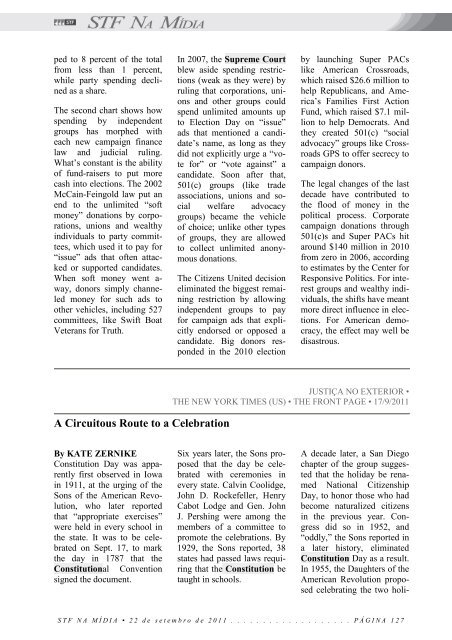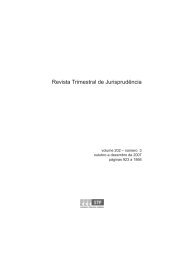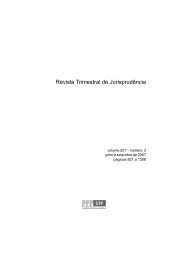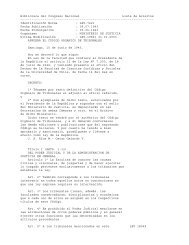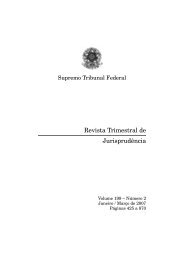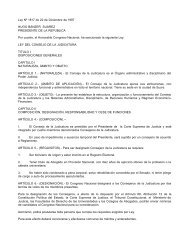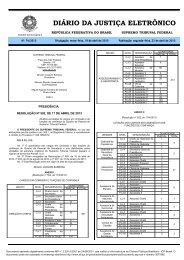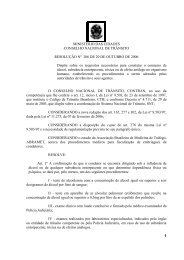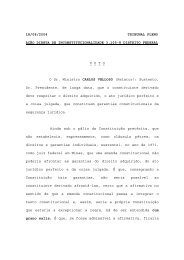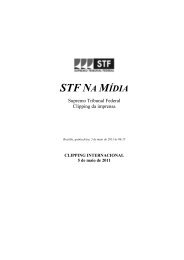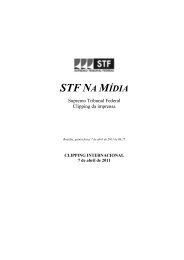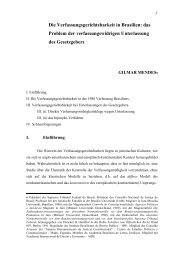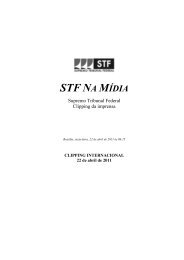STF NA MÍDIA
STF NA MÍDIA
STF NA MÍDIA
You also want an ePaper? Increase the reach of your titles
YUMPU automatically turns print PDFs into web optimized ePapers that Google loves.
ped to 8 percent of the total<br />
from less than 1 percent,<br />
while party spending declined<br />
as a share.<br />
The second chart shows how<br />
spending by independent<br />
groups has morphed with<br />
each new campaign finance<br />
law and judicial ruling.<br />
What’s constant is the ability<br />
of fund-raisers to put more<br />
cash into elections. The 2002<br />
McCain-Feingold law put an<br />
end to the unlimited “soft<br />
money” donations by corporations,<br />
unions and wealthy<br />
individuals to party committees,<br />
which used it to pay for<br />
“issue” ads that often attacked<br />
or supported candidates.<br />
When soft money went a-<br />
way, donors simply channeled<br />
money for such ads to<br />
other vehicles, including 527<br />
committees, like Swift Boat<br />
Veterans for Truth.<br />
In 2007, the Supreme Court<br />
blew aside spending restrictions<br />
(weak as they were) by<br />
ruling that corporations, unions<br />
and other groups could<br />
spend unlimited amounts up<br />
to Election Day on “issue”<br />
ads that mentioned a candidate’s<br />
name, as long as they<br />
did not explicitly urge a “vote<br />
for” or “vote against” a<br />
candidate. Soon after that,<br />
501(c) groups (like trade<br />
associations, unions and social<br />
welfare advocacy<br />
groups) became the vehicle<br />
of choice; unlike other types<br />
of groups, they are allowed<br />
to collect unlimited anonymous<br />
donations.<br />
The Citizens United decision<br />
eliminated the biggest remaining<br />
restriction by allowing<br />
independent groups to pay<br />
for campaign ads that explicitly<br />
endorsed or opposed a<br />
candidate. Big donors responded<br />
in the 2010 election<br />
by launching Super PACs<br />
like American Crossroads,<br />
which raised $26.6 million to<br />
help Republicans, and America’s<br />
Families First Action<br />
Fund, which raised $7.1 million<br />
to help Democrats. And<br />
they created 501(c) “social<br />
advocacy” groups like Crossroads<br />
GPS to offer secrecy to<br />
campaign donors.<br />
The legal changes of the last<br />
decade have contributed to<br />
the flood of money in the<br />
political process. Corporate<br />
campaign donations through<br />
501(c)s and Super PACs hit<br />
around $140 million in 2010<br />
from zero in 2006, according<br />
to estimates by the Center for<br />
Responsive Politics. For interest<br />
groups and wealthy individuals,<br />
the shifts have meant<br />
more direct influence in elections.<br />
For American democracy,<br />
the effect may well be<br />
disastrous.<br />
A Circuitous Route to a Celebration<br />
JUSTIÇA NO EXTERIOR •<br />
THE NEW YORK TIMES (US) • THE FRONT PAGE • 17/9/2011<br />
By KATE ZERNIKE<br />
Constitution Day was apparently<br />
first observed in Iowa<br />
in 1911, at the urging of the<br />
Sons of the American Revolution,<br />
who later reported<br />
that “appropriate exercises”<br />
were held in every school in<br />
the state. It was to be celebrated<br />
on Sept. 17, to mark<br />
the day in 1787 that the<br />
Constitutional Convention<br />
signed the document.<br />
Six years later, the Sons proposed<br />
that the day be celebrated<br />
with ceremonies in<br />
every state. Calvin Coolidge,<br />
John D. Rockefeller, Henry<br />
Cabot Lodge and Gen. John<br />
J. Pershing were among the<br />
members of a committee to<br />
promote the celebrations. By<br />
1929, the Sons reported, 38<br />
states had passed laws requiring<br />
that the Constitution be<br />
taught in schools.<br />
A decade later, a San Diego<br />
chapter of the group suggested<br />
that the holiday be renamed<br />
National Citizenship<br />
Day, to honor those who had<br />
become naturalized citizens<br />
in the previous year. Congress<br />
did so in 1952, and<br />
“oddly,” the Sons reported in<br />
a later history, eliminated<br />
Constitution Day as a result.<br />
In 1955, the Daughters of the<br />
American Revolution proposed<br />
celebrating the two holi-<br />
S T F N A M Í D I A • 2 2 d e s e t e m b r o d e 2 0 1 1 . . . . . . . . . . . . . . . . . . . P Á G I N A 1 2 7


